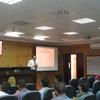Explore all the information on
Poultry litter
Poultry litter is the mix of bedding material, manure and feathers that result from intensive poultry production. This includes litter from meat chickens (broilers), egg-laying chickens (layers) kept under barn conditions, turkeys, ducks and quails. Poultry bedding material consists of wood shavings, pine straw, peanut hulls, and other absorbent dry low-cost materials and is another possible source of pathogenic contamination for poultry. It is generally recommended that farmers keep litter as dry as possible, replace the top layer of the litter with a new one, and apply acid-based litter amendments. Keeping litter dry is a critical part of overall management on every poultry farm. Litter conditions influence bird performance, which in turn affects profits of growers and integrators. Dry litter helps control ammonia levels, provides a healthy flock environment, and reduces condemnations due to hock and footpad burns and breast blisters.
Does anybody have experience in poultry litter gasification for the generation of electrical energy? Any supplier that has equipment already installed? What are the pros and cons? What is biochar?
Thanks!...
Comments : 3
Recommendations: 0
On November 14-16, 2016, the UGA Cold Weather Management Workshop will be conducted at the Oconee County Civic Center in Watkinsville, Georgia, a few miles from the University of Georgia. This intensive training program has been specifically designed for those who want to learn more about the design and management of modern poultry houses. The workshop consists of lectures as well as hands on group exercises designed to help attendees gain a firm understanding of the principles...
Comments : 4
Recommendations: 0
INTRODUCTION There are several challenges associated with maintaining profitability in large tom turkey production. Among these are choosing the commercial genotype or strain that optimizes feed conversion ratio (FCR), ending weight (EW) and breast yield according to each company’s market needs. There have been concerns with “skeletal weakness” in commercial toms for over 40 years. In 1971 the National...
Comments : 0
Recommendations: 1
Dr. Susan Watkins, University of Arkansas Poultry Extension Specialist, was presented with the 2016 Industry Leader of the Year Award by The Poultry Federation at the 57th Annual Poultry Festival held June 17-18 in Rogers, AR.
Dr. Susan Watkins has served as the Poultry Extension Specialist for...
Comments : 1
Recommendations: 0
Excess moisture in poultry houses causes both welfare and performance issues. We cannot eradicate moisture in poultry litter and neither do we want to. Moisture enters the poultry house in many different forms. This presentation aims to discuss how to identify moisture entering your house and ways of controlling it.
Moisture enters your poultry house via:
...
Comments : 8
Recommendations: 0
Footpad dermatitis is a common problem in poultry. Severe cases of footpad dermatitis have a negative impact on animal welfare as well as on the commercial result of broiler units. The quality of the litter is unquestionably a major impact factor on the development of footpad dermatitis. A combination of wet litter and unspecified chemical factors in the litter are thought to be the major cause of the footpad dermatitis. Beside...
Comments : 9
Recommendations: 0
Dear All, I have visited a big farm in Peru, La Callera, using Layer Manure to feed layers. The level was more than 5%. My questions are the following: 1. Do you have the experience of the use of poultry manure to feed poultry? 2. What is nutritional values of the Layer manure? 3. What are the risk for Layers and consumers? 4. Which could be the maximum level? Thank you ...
Comments : 30
Recommendations: 0
what about the dried manure microbial contamination? ...
Comments : 1
Recommendations: 0
INTRODUCTION
Because wet litter impacts broiler welfare and performance it is of vital importance to poultry producers. Wet litter in poultry houses may be caused by a number of factors including mycotoxins, disease, gut health, nutrition, management, housing and environment. Nutrition, including reducing mycotoxin contamination of feed, plays an important part in controlling litter moisture....
Comments : 0
Recommendations: 0
Introduction Footpad dermatitis (FPD), also called footpad lesions or pododermatitis, is a major welfare concern in broiler chickens. Severe FPD is likely to be painful for the birds, and because of its association with litter quality it also reflects other welfare aspects (Haslam et al. , 2007).Wet litter is the most important factor causing FPD in broiler chickens (Shepherd et al. 2010). It can be...
Comments : 6
Recommendations: 0
...
Comments : 0
Recommendations: 1
The sublimation of a simple substance or of a chemical compound is its transition from a solid state to a gaseous state without passing through the liquid state. In modern language this term is also generically used to indicate the opposite process, where the term de-frosting or inverse sublimation would be more correct. At times, certain insects can be seen walking on water and as is known it is possible to make a metal clip...
Comments : 0
Recommendations: 0
Summary A feeding study was conducted to compare the effects of litter material, dietary fibre and sex on growth performance, organ development, mucosal morphometry and gut microbial communities in broilers. Seven hundred twenty day old Cobb chicks were allocated to 24 floor pens in a 2 x 2 x 2 factorial design with 3 pens of 30 birds per replicate (3 pens of males and 3 pens of females). Factors were: litter material, paper or hardwood shavings; dietary fibre,...
Comments : 3
Recommendations: 0
What measures should be adopted in case of wet litter condition in winter as it reduces production capability of layers? ...
Comments : 1
Recommendations: 0
Poultry farmers are consistently looking at ways to reduce costs, increase farm efficiencies and maximise their return on investment. For many, the management of poultry litter is one aspect of their operations that presents its own challenges. For fertiliser use, spent litter is commonly perceived as bulky, having an inconsistent nutrient content, and there are concerns that use as a land applied fertiliser may result in environmental damage due to nutrient...
Comments : 4
Recommendations: 0
A major component of broiler management is maintaining good litter quality throughout the flock. Litter quality is negatively influenced by moisture. As litter moisture increases, litter quality decreases. Factors that affect litter moisture include drinker management, bird health, bird density, ventilation rates, litter depth and litter type. Typically broiler facilities are bedded with materials that have moisture content less than 10%. Under...
Comments : 13
Recommendations: 0
INTRODUCTION Animal husbandry suffers from losses due to contamination with pathogenic bacteria. Their resultant impacts in animals include lower weight gains and increased mortality. Banning the use of in-feed antibiotics (AGPs) in livestock, as has happened in the EU, placed more pressure on animal producers and feed millers. In this context, organic acids have long been used to counteract gram-negative pathogenic bacteria in animal feed; and...
Comments : 4
Recommendations: 0
Definition: Aluminum sulfate (alum) is added to poultry litter in the poultry house to reduce ammonia volatilization. Purpose: Over half of the nitrogen excreted by chickens is lost to the atmosphere as ammonia before the litter is removed from poultry houses. Research has shown that alum additions to poultry litter greatly reduces ammonia emissions. Lower ammonia levels in poultry houses...
Comments : 5
Recommendations: 0
Footpad dermatitis (FPD)...
Comments : 4
Recommendations: 0
In the late 1950´s it took approximately 50 days for a male broiler to reach a weight of 1.7 lbs. By the early 2000´s the same weight could be reached at 21 days of age (Havenstein, et. al, 2003). Today it can be reached in as little as 18 days. One of the many challenges of managing today´s fast growing broilers is maintaining proper litter quality. In general, a fast growing bird consumes feed at a higher rate than a slower...
Comments : 0
Recommendations: 0







.jpg&w=3840&q=75)






.jpg&w=3840&q=75)



.jpg&w=3840&q=75)











